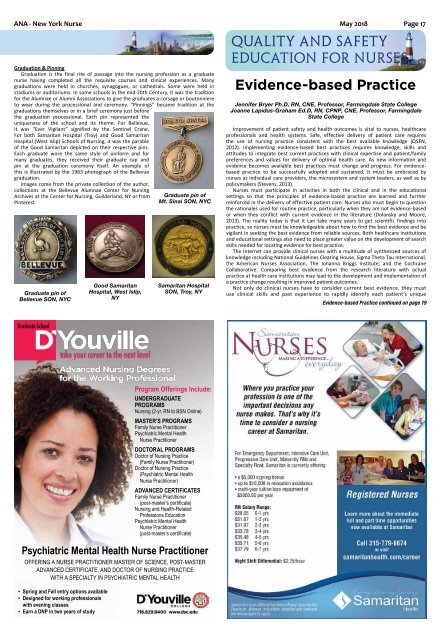ANA New York Nurse - May 2018
Create successful ePaper yourself
Turn your PDF publications into a flip-book with our unique Google optimized e-Paper software.
<strong>ANA</strong> - <strong>New</strong> <strong>York</strong> <strong>Nurse</strong> <strong>May</strong> <strong>2018</strong> Page 17<br />
Graduation & Pinning<br />
Graduation is the final rite of passage into the nursing profession as a graduate<br />
nurse having completed all the requisite courses and clinical experiences. Many<br />
graduations were held in churches, synagogues, or cathedrals. Some were held in<br />
stadiums or auditoriums. In some schools in the mid-20th Century, it was the tradition<br />
for the Alumnae or Alumni Associations to give the graduates a corsage or boutonniere<br />
to wear during the processional and ceremony. “Pinnings” became tradition at the<br />
graduations themselves or in a brief ceremony just before<br />
the graduation processional. Each pin represented the<br />
uniqueness of the school and its theme. For Bellevue,<br />
it was “Ever Vigilant” signified by the Sentinel Crane.<br />
For both Samaritan Hospital (Troy) and Good Samaritan<br />
Hospital (West Islip) Schools of Nursing, it was the parable<br />
of the Good Samaritan depicted on their respective pins.<br />
Each graduate wore the same style of uniform and for<br />
many graduates, they received their graduate cap and<br />
pin at the graduation ceremony itself. An example of<br />
this is illustrated by the 1963 photograph of the Bellevue<br />
graduation.<br />
Images come from the private collection of the author,<br />
collections at the Bellevue Alumnae Center for Nursing<br />
Archives at the Center for Nursing, Guilderland, NY or from<br />
Pinterest.<br />
Graduate pin of<br />
Bellevue SON, NYC<br />
Good Samaritan<br />
Hospital, West Islip,<br />
NY<br />
Graduate pin of<br />
Mt. Sinai SON, NYC<br />
Samaritan Hospital<br />
SON, Troy, NY<br />
Quality and Safety<br />
Education for <strong>Nurse</strong>s<br />
Evidence-based Practice<br />
Jennifer Bryer Ph.D, RN, CNE, Professor, Farmingdale State College<br />
Joanne Lapidus-Graham Ed.D, RN, CPNP, CNE, Professor, Farmingdale<br />
State College<br />
Improvement of patient safety and health outcomes is vital to nurses, healthcare<br />
professionals and health systems. Safe, effective delivery of patient care requires<br />
the use of nursing practice consistent with the best available knowledge (QSEN,<br />
2012). Implementing evidence-based best practices requires knowledge, skills and<br />
attitudes to integrate best current practices with clinical expertise and patient/family<br />
preferences and values for delivery of optimal health care. As new information and<br />
evidence becomes available best practices must change and progress. For evidencebased<br />
practice to be successfully adopted and sustained, it must be embraced by<br />
nurses as individual care providers, the microsystem and system leaders, as well as by<br />
policymakers (Stevens, 2013).<br />
<strong>Nurse</strong>s must participate in activities in both the clinical and in the educational<br />
settings so that the principles of evidence-based practice are learned and further<br />
reinforced in the delivery of effective patient care. <strong>Nurse</strong>s also must begin to question<br />
the rationales used for routine practice, particularly when they are not evidence-based<br />
or when they conflict with current evidence in the literature (Dolansky and Moore,<br />
2013). The reality today is that it can take many years to get scientific findings into<br />
practice, so nurses must be knowledgeable about how to find the best evidence and be<br />
vigilant in seeking the best evidence from reliable sources. Both healthcare institutions<br />
and educational settings also need to place greater value on the development of search<br />
skills needed for locating evidence for best practice.<br />
The Internet can provide clinical nurses with a multitude of synthesized sources of<br />
knowledge including National Guidelines Clearing House, Sigma Theta Tau International,<br />
the American <strong>Nurse</strong>s Association, The Johanna Briggs Institute, and the Cochrane<br />
Collaborative. Comparing best evidence from the research literature with actual<br />
practice at health care institutions may lead to the development and implementation of<br />
a practice change resulting in improved patient outcomes.<br />
Not only do clinical nurses have to consider current best evidence, they must<br />
use clinical skills and past experience to rapidly identify each patient’s unique<br />
Evidence-based Practice continued on page 19<br />
Program Offerings Include:<br />
UNDERGRADUATE<br />
PROGRAMS<br />
Nursing (2-yr. RN to BSN Online)<br />
MASTER’S PROGRAMS<br />
Family <strong>Nurse</strong> Practitioner<br />
Psychiatric Mental Health<br />
<strong>Nurse</strong> Practitioner<br />
DOCTORAL PROGRAMS<br />
Doctor of Nursing Practice<br />
(Family <strong>Nurse</strong> Practitioner)<br />
Doctor of Nursing Practice<br />
(Psychiatric Mental Health<br />
<strong>Nurse</strong> Practitioner)<br />
ADVANCED CERTIFICATES<br />
Family <strong>Nurse</strong> Practitioner<br />
(post-master’s certificate)<br />
Nursing and Health-Related<br />
Professions Education<br />
Psychiatric Mental Health<br />
<strong>Nurse</strong> Practitioner<br />
(post-master’s certificate)<br />
Psychiatric Mental Health <strong>Nurse</strong> Practitioner<br />
OFFERING A NURSE PRACTITIONER MASTER OF SCIENCE, POST-MASTER<br />
ADVANCED CERTIFICATE, AND DOCTOR OF NURSING PRACTICE<br />
WITH A SPECIALTY IN PSYCHIATRIC MENTAL HEALTH<br />
• Spring and Fall entry options available<br />
• Designed for working professionals<br />
with evening classes<br />
• Earn a DNP in two years of study

















